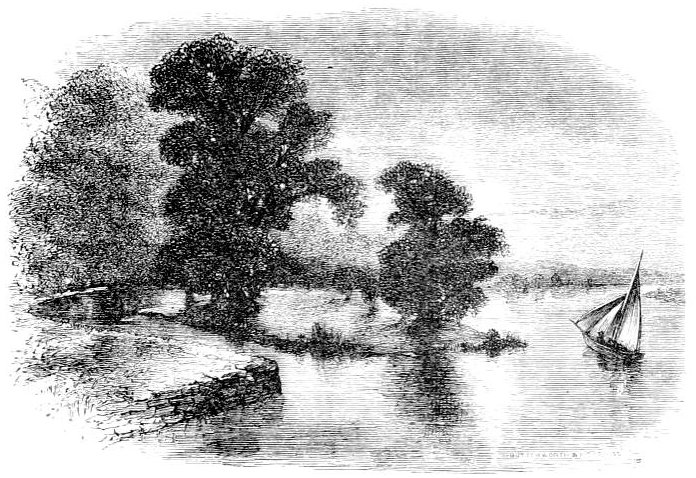
Junction of the Cherwell and the Thames. 1859. From The Book of the Thames from its Rise to its Fall, p. 113. [Click on image to enlarge it.] Text and formatting by George P. Landow. [You may use this image without prior permission for any scholarly or educational purpose as long as you (1) credit the University of Pittsburgh and the Internet Archive and (2) link your document to this URL in a web document or cite the Victorian Web in a print one.]
Commentary by the Halls
At the termination of Christ Church Meadow occurs the junction of the Cherwell and the Thames: the river so dear to Alma Mater has its source in the Arbury Hills, near Daventry, in Northamptonshire: it enters Oxfurdshire near Claydon, flows past the town of Lanbury, through Islip and several other villages, runs its course of about forty miles (but nowhere navigable), and on its arrival at Oxford surrounds an island appertaining to Magdalen College (where it is crossed by a bridge of great beauty), running beside "Addison's Walk," waters the banks of the Botanic Garden, passing by the side of Christ Church Meadow and its tree-embowered walks, and loses itself in the great river in whose company it journeys to the sea. Our noble old topographer, Camden, takes the opportunity of this locality for an eloquent praise of the city in his "Britannia." He says, "Where Cherwell is confluent with Isis, and pleasant aits, or islets, lye dispersed by the sundry dissevering of Avaters, there the most famous University of Oxford sheweth itself aloft in a champion plaine. Oxford, I say, our most noble Athens, the muses-seate, and one of England's stays — nay, the sun, the eye, and the soul thereof, from whence religion, civility, and learning, are spread most plenteously into all parts of the realm. A fair and goodly city, whether a man respect the seemly beauty of private houses, or the stately magnificence of public buildings, together with the wholesome site or pleasant prospect thereof. Whence it came to pass that of this situation it was (as writers record) in ancient times called Bellositim. [113-14]
Bibliography
Hall, Mr. and Mrs. S. C. The Book of the Thames from its Rise to its Fall. London: Arthur Hall, Virtue, and Cp., 1959. Internet Archive version of a copy in the William and Mary Darlington Memorial Libray, the University of Pittsburgh. Web. 10 March 2012.
Last modified 10 March 2012